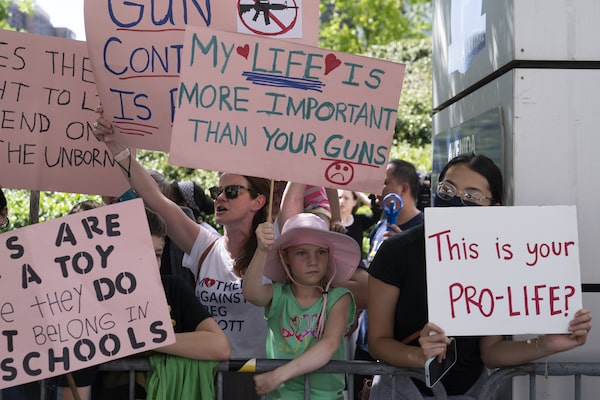
People light candles and lay flowers at a makeshift memorial outside the Uvalde County Courthouse on May 27.CHANDAN KHANNA/AFP/Getty Images
The last time Antonio Rodriguez saw Alexandria Rubio and Tess Mata was on May 19, when their little league softball team, the Bandits, notched a hard-fought 18-to-17 victory over the rival Bruins in Uvalde, Tex. Five days later, the two girls would be among the 19 students killed in a mass shooting at Robb Elementary School.
Mr. Rodriguez, the Bandits’ coach, has no doubt about the reason such massacres continue to happen in the U.S.
“I don’t like guns. I don’t own them,” the 64-year-old landscaper said as he paid his respects at the school. “We need more controls.”
Mr. Rodriguez’s strong views set him apart in a state with some of the most lenient gun laws in the U.S. In the days following the killings, which also left two teachers dead, many residents in this town of 15,000 are trying to reconcile their support for tougher rules with the pervasive gun culture in this corner of the country.
“We were born with rifles and pistols. You had to defend yourself from rattlesnakes,” said Pete Garza, 56, who grew up on a farm. “We learned to respect these weapons. We learned how to handle them safely, properly. We didn’t hurt people.”
Mr. Garza, who works for a beer distributor, still owns guns for hunting. And he wasn’t particularly bothered by a National Rifle Association convention unfolding three hours down the road in Houston, just days after the attack.
“They’re not an evil organization. They didn’t expect this to happen,” he said.
But he believes assault rifles, such as the ones the 18-year-old gunman in Uvalde purchased legally just days before carrying out the massacre, should be tightly restricted: “The laws need to change. They need to be stiffer.”
Texas does not require a state-level licence to own a gun, has no restrictions on magazine size or assault weapons, and allows some sales without background checks. Last year, Governor Greg Abbott signed a law that allows people to carry guns in public without a permit.
“This is Texas. We use guns to be protected, but at the same time, they shouldn’t sell legal rifles that are really, really dangerous,” said Eva Martinez, 35, as she sat in the bleachers at Uvalde’s fairgrounds after a vigil for the shooting’s victims.
Thomas Nordwick, CEO of Uvalde Memorial Hospital, said there is “certainly room for improvement in our current laws and policies,” but was careful not to press for specific measures.
Also needed, he said, are improvements to mental-health supports and better security at schools: video surveillance, locking mechanisms on doors and safe rooms for children to hide from shooters.
“You don’t get too many mentally stable people running around shooting other people,” he said, stressing there should be measures in place to ensure people who should not have guns aren’t able to access them. “I think we should be doing all we can there.”
Mr. Nordwick, whose hospital treated 15 of the wounded after the shooting, also pointed to the large number of illegal guns in circulation in the U.S. “If you outlaw guns, the only people who will have guns are outlaws. My dad used to say that, and I think there’s some truth to that.”

Seven-year-old Evelyn Haggard, centre, holds up a sign while protesting the National Rifle Association's annual meeting in Houston May 27.Jae C. Hong/The Associated Press
The U.S. has the world’s highest rate of gun ownership, with more firearms in the country than there are people. Illegal guns typically start out as legal ones: Criminal networks arrange for front men to buy guns legally in states that have few restrictions, then distribute them around the country.
The U.S. also has a homicide rate significantly higher than that of other wealthy countries: nearly seven per 100,000, compared with two per 100,000 in Canada and 1.2 per 100,000 in Britain. Guns are the leading cause of death for school-age children.
“It’s a crazy world we live in and I don’t think it’s going to change. I don’t think you’re going to solve it all with taking guns away either,” Mr. Nordwick said. “The answer lies somewhere in the middle, I think.”
Polling has consistently shown most people in the U.S. support tighter gun control. But attempts at legislative action after previous mass shootings, including the 2012 massacre at Sandy Hook Elementary School in Newtown, Conn., which left 20 schoolchildren and six teachers dead, have failed to pass Congress.
The National Rifle Association, which makes copious political contributions and boasts a loyal membership, has lobbied hard against all forms of gun control.
“The campaign donations the NRA gives are just legalized bribery for politicians. The majority of people want these common-sense changes to gun laws, but the politicians are bought off by the corporations,” said Timi Walters, 42, a construction worker, who was among several thousand protesters outside the NRA’s annual meeting on Friday.
His wife, Kelley Walters, said she owns a handgun that her father once gave her for protection. She keeps it in a locked gun case inside a locked safe to ensure her three-year-old daughter cannot access it. “I would gladly give it up. It does not make me feel safer,” said Ms. Walters, a 39-year-old therapist.
Taye Marshall, 53, stood against a police barrier with his 11-year-old son and called out to NRA members heading into the convention. “Say ‘Uvalde.’ Say it.”
Twenty-one crosses bearing the names of those killed in the mass shooting at Robb Elementary School.CALLAGHAN O'HARE/The New York Times News Service
Mr. Marshall owns both a shotgun and a deer rifle for hunting. The maximum either of them can hold is three shots. “I’m a fourth-generation Texan, I grew up with guns,” he said. “We don’t need AR-15s. There’s no need for it. You don’t hunt with that rifle.”
Tom Adkins, a conservative media personality attending the NRA conference, said there are so many guns in the U.S. that law-abiding people need access to weapons to protect themselves.
On two occasions – once on the street in Philadelphia and another time when a fight broke out in front of his house – Mr. Adkins said he saw guns pulled, but managed to stop the situations by pulling out a bigger gun of his own.
“You have to be able to defend yourself against bad people,” he told The Globe and Mail outside the convention centre. “What do you do if a six-foot-four line backer tries to mess with you?”
In Uvalde, it took police more than an hour to move in on the shooter, despite 19 armed officers gathering outside the classroom.
Because the shooter got inside through a door that had been left propped open, Mr. Adkins said, the focus should be on school security. “If someone walked into my house and started shooting, is it the gun’s fault?” he said. “No. It’s my fault for not locking the door.”
Standing outside Robb Elementary School on Friday, a survivor from a previous mass shooting said the carnage in Uvalde had reopened old wounds. “For the past two days, I couldn’t sleep,” said Efe Obayagbona.
“My daughter, she’s eight years old, she told me ‘Daddy, I don’t want to go to school,’” he said. “I don’t know how to explain to her.”
A truck driver from Austin, Tex., Mr. Obayagbona was one of 25 people injured on Aug. 31, 2019, when a man who had been fired from his job drove along a highway shooting from his car. Eight people were killed.
Mr. Obayagbona called for government action, but held out little hope.
“This is something I think our leaders can do better. It doesn’t have to happen again,” he said. “If Sandy Hook happened how many years ago, and still there are no changes, the question is, who is going to be next?”
Warning: This video contains strong language and emotional distress. Desperate for information and to see their children, parents clash with police in the immediate aftermath of the Robb Elementary School shooting in Uvalde, Tex., where 19 children and two teachers were killed.
The Globe and Mail
Our Morning Update and Evening Update newsletters are written by Globe editors, giving you a concise summary of the day’s most important headlines. Sign up today.
 Adrian Morrow
Adrian Morrow Molly Hayes
Molly Hayes